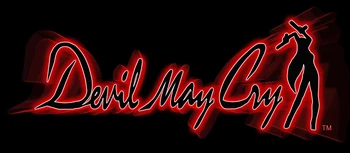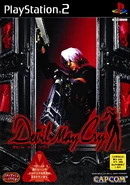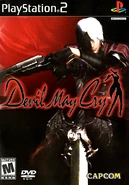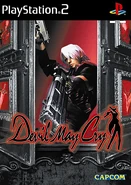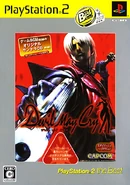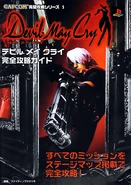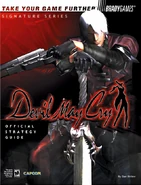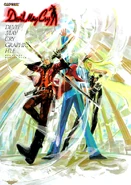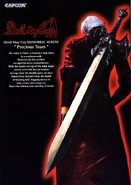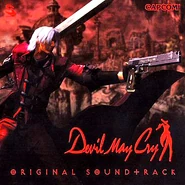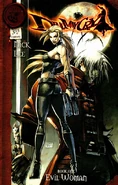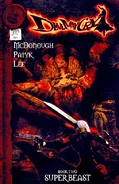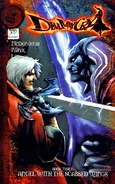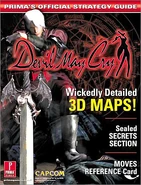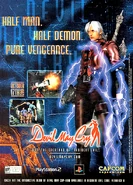Devil May Cry (デビル・メイ・クライ) is a 3D hack & slash action game developed by Capcom Production Studio 4 and published by Capcom in 2001 for the PlayStation 2.

Devil May Cry 1 trailer
Trailer
It is the first game in the Devil May Cry series. The game was originally conceived in 1999 as the earliest version of the survival horror game Resident Evil 4 but due to the staff feeling it would not fit the Resident Evil franchise, the project dropped its ties to Resident Evil 4 and was made into its own story instead.
Devil May Cry received mainly postive reviews upon its release and is considered to be a classic among action games as well as one of the greatest video games of all time. In 2012, the game was included in an HD compilation, alongside Devil May Cry 2 and Devil May Cry 3, ported to the PlayStation 3 and later to PlayStation 4, Xbox One and PC in 2018. Devil May Cry was also ported to the Nintendo Switch, releasing through digital download-only in June 2019.
Set in modern times on the fictional Mallet Island, the story centers on the characters Dante and Trish and their quest to confront the demon lord Mundus. The story is told primarily through a mixture of cutscenes, which use the game's engine and several pre-rendered full motion videos.
Gameplay[]
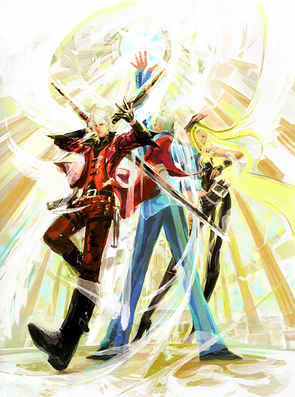
Art by Makoto Tsuchibayashi.
The gameplay consists of levels called "missions", where players must fight numerous enemies, perform platforming tasks, and occasionally solve puzzles to progress through the story. The player's performance in each mission is given a letter grade of A, B, C, or D, with an additional top grade of S. Grades are based on the time taken to complete the mission, the amount of "red orbs" gathered (the in-game currency obtained from defeated enemies), how "stylish" their combat was, item usage, and damage taken.
"Stylish" combat is defined as performing an unbroken series of attacks while avoiding damage, with player performance tracked by an on-screen gauge. The more hits the player makes, the higher the gauge rises. The gauge starts at "Dull"; progresses through "Cool", "Bravo", and "Awesome"; and peaks at "Stylish". The gauge terms are similar to the grades you get at the end of the missions. When the character receives damage, the style rating resets back to "Dull". Players can also maintain their style grade by taunting enemies at close range. These combat mechanics are used for most of the game, with three areas that are exceptions. The first is an underwater first-person shooter area, where the player battles enemies with a needle gun. Secondly, during the final boss battle, the gameplay switches to a rail shooter-type environment, and finally a similar rail-shooter level is used for the character's escape from the island by airplane.
The player can temporarily transform the character into a more powerful demonic creature by using the "Devil Trigger" ability. Doing so adds powers based on the current weapon and changes the character's appearance. The transformations typically increase strength and defense, slowly restore health, and grant special attacks. It is governed by the Devil Trigger gauge, which depletes as the ability is used, and is refilled by attacking enemies or taunting in normal form.
Devil May Cry contains puzzles and other challenges besides regular combat. The main storyline often requires the player to find key items to advance, in a manner similar to puzzles in the Resident Evil games, as well as optional platforming and exploration tasks to find hidden caches of "orbs". Side quests, called "Secret Missions" in the game, are located in hidden or out-of-the-way areas and are not required for completion, but provide permanent power-ups. They typically challenge the player to defeat a group of enemies in a specific manner or within a time limit. Rewards for all optional puzzles and challenges come in different types of "orbs" which give bonuses such as allowing the player to purchase power-ups, extend the Devil Trigger ability, or boost total health.
By beating the game on Hard Mode, players can unlock Sparda (Dante and Vergil's father) as an alternate skin and replay the entire game as him.
Story[]
In the series' chronological order, the game's events are set after Devil May Cry 3: Dante's Awakening and before Devil May Cry 2.
Devil May Cry begins with Dante being attacked in his office by a mysterious woman named Trish. He impresses her by easily brushing off her assault, and tells her that he hunts demons in pursuit of those who killed his mother and brother. She says the attack was a test, and that the demon emperor Mundus, whom Dante holds responsible for the deaths of his family, is planning a return. The scene jumps to their arrival at an immense castle, whereupon Trish abruptly leaps and vanishes over a high wall.
Dante explores the castle and encounters the game's stock enemies, demonic marionettes. He also finds a new sword called Alastor, and battles the first boss, a giant spider/scorpion demon named Phantom. Dante wins the battle, but in what becomes a recurring theme, the defeated boss monster reappears a short time later in a corridor, forcing the player to choose a narrow escape or to fight in the tight confines. After further exploration and combat, Dante battles a demon named Nelo Angelo, who impresses Dante with his confidence. The demon wins, but suddenly flees upon seeing the half-amulet Dante wears. The demon attacks twice more in later missions, and is eventually revealed to be Dante's identical twin brother, Vergil. After Vergil's final defeat, his amulet joins with his brother's half, and "Force Edge", the game's default sword which belonged to the twins' father, becomes the powerful Sparda sword.
When Dante next meets Trish, she betrays him and reveals that she too is working for Mundus. But when her life is endangered, Dante chooses to save her. Saying he only did so because of her resemblance to his mother, he warns her to stay away. Yet when he finally confronts Mundus, who is about to kill Trish, Dante again chooses to save her and is injured. Mundus tries to finish him off, but Trish takes the attack instead. This unleashes Dante's full power. Dante and Mundus then battle on another plane of existence.
Dante is victorious, and leaves the amulet and sword with Trish's immobile body before departing. Mundus returns and corners Dante, who is now back to his regular strength, before he can flee the island; Trish also returns and lends Dante her power. Dante defeats Mundus, who vows to return and rule the human world. When Trish tries to apologize she begins to cry, and Dante tells her it means she has become human and not just a devil, because "devils never cry". Dante and Trish escape on a plane as the island collapses. After the credits, it is revealed that Dante and Trish are working together as partners, and have renamed the shop "Devil May Cry".
Characters[]
Enemies[]
- Phantom - is a boss character and one of Mundus' Generals. He is a massive demon resembling a fiery tarantula with a scorpion-like tail. He appears briefly in Devil May Cry 2.
- Frost - a lizard-like demon harnessing the power of ice. A Frost can freeze Dante in place to strike him if the player is not quick enough to avoid their attacks. A host of these creatures returned in Devil May Cry 4.
- Griffon
- Nelo Angelo
- Nightmare
- Mundus
Development[]
First hinted in early December 1999,[1] Devil May Cry started out as the earliest incarnation of the survival horror game Resident Evil 4. Initially developed for the PlayStation 2, the game was directed by Hideki Kamiya after producer Shinji Mikami requested him to create a new entry in the Resident Evil series.[2] Around the turn of the millennium,[3] regular series writer Noboru Sugimura[4] created a scenario for the title, based on Kamiya's idea to make a "very cool and stylized" action game. The original story was based on unraveling the mystery surrounding the body of protagonist Tony, an invincible man with skills and an intellect exceeding that of normal people, his superhuman abilities explained with biotechnology. As Kamiya felt the playable character did not look brave and heroic enough in battles from a fixed angle, he decided to drop the prerendered backgrounds from previous Resident Evil installments and instead opted for a dynamic camera system. This new direction required the team to make a trip to Europe where they spent eleven days in the United Kingdom and Spain photographing things like Gothic statues, bricks, and stone pavements for use in textures.[5]
Though the developers tried to make the "coolness" theme fit into the world of Resident Evil, Mikami felt it strayed too far from the series' survival horror roots and gradually convinced all of the staff members to make the game independent from it.[6] Kamiya eventually rewrote the story to be set in a world full of demons and changed the hero's name to "Dante". The cast of characters remained largely identical to that in Sugimura's scenario, although appearances of the hero's mother and father were written out of the story. The game's new title was revealed as Devil May Cry in November 2000.
The game was developed by Team Little Devils, a group of staff members, including Kamiya, Mikami and head developer Atsushi Inaba, within Capcom Production Studio 4. Some of the major gameplay elements were partially inspired by a bug found in Onimusha: Warlords. During a test-play, Kamiya discovered that enemies could be kept in the air by slashing them repeatedly, which lead to the inclusion of juggles by gunfire and sword strikes in Devil May Cry.[7] According to the director, Devil May Cry was designed from the ground up around Dante's acrobatics and combat abilities.[8] The decision was made late in the development process to change the game to a more mission-based advancement, instead of the more open-ended structure of the Resident Evil games.[9] Devil May Cry's difficulty was intentional, according to Kamiya, who called it his "challenge to those who played light, casual games".[10] Conceptual designs were handled by Makoto Tsuchibayashi.
A port for the Nintendo Wii console was in development by Red Fly Studios at one point, before being cancelled.[11]
In a November 2017 interview, Kamiya expressed interest in making a remake of the game.[12]
Merchandise[]
The game's success led to various media adaptations and merchandise, including comic books and novelizations. One novel series, simply titled Devil May Cry, written by Shin-Ya Goikeda with the assistance of Hideki Kamiya, was first published in Japan in 2003 by Kadokawa Shoten Publishing Co., LTD, and was released in English in 2006 by TOKYO POP. The first volume spans from the death of Dante's mother Eva until the beginning of the first Devil May Cry, although as of the release of Devil May Cry 3 it is considered mostly non-canon. However, parts of the novels might still remain within the canon story. Dante's alias as "Tony Redgrave" is also mentioned in the Devil May Cry: The Animated Series and engraved on the on all appearances of Luce and Ombra and Ebony and Ivory. Also, the novel provides the only explanation as to where engraving ".45 Art Warks" comes from. Nico from Devil May Cry 5 Is stated to be the Granddaughter of Nell Goldstein.
Hideki Kamiya was able to work closely with Goikeda during the development of the novel, stating that his depiction of Dante and Goikeda's depiction are very similar.
Reception[]
Devil May Cry received a "Gold" sales award from the Entertainment and Leisure Software Publishers Association (ELSPA),[13] indicating sales of at least 200,000 copies in the United Kingdom.[14] By July 2006, Devil May Cry had sold 1.1 million copies and earned $38 million in the United States alone. Next Generation ranked it as the 48th highest-selling game launched for the PlayStation 2, Xbox or GameCube between January 2000 and July 2006 in that country. Combined sales of the Devil May Cry series reached 2 million units in the United States by July 2006.[15]
The game received critical acclaim, with reviews from video game news websites typically praising its gameplay innovations, action, visuals, camera control, and gothic ambience.[16][17][18][19][20][21][22] The game also received positive reviews from video game print publications for similar reasons.[23][24] Game Informer summarized their review by saying the game "makes Resident Evil look like a slow zombie".[25] Devil May Cry also frequents several Top Video Games of All Time lists. Gamefury, for instance, listed Devil May Cry at #31 in their Top 40 Console Games of All Time feature.[26] In 2010, IGN listed it at #42 in their "Top 100 PlayStation 2 Games".[27] Dante also received noteworthy praise to the point of becoming one of the most famous characters in gaming.[28][29][30]
The game was also subject to criticism, however. Next Generation objected to the difficulty level, wondering if the challenge was added to prolong the gameplay.[31] The Electric Playground pointed to the unusual control scheme and lack of configuration options.[21] GameSpy cited the camera's behavior, the learning curve for the controls, and graphical shortcomings such as flickering and jagginess.[19] GameSpot criticized the game's conclusion for its dramatic change in gameplay to a rail shooter-like style at the story's climax, as well as a leveling-off of the difficulty.[18] Lastly, Gamecritics felt that the story was overly short and the characters were underdeveloped.[22]
Legacy[]
Devil May Cry has spawned a sequel, Devil May Cry 2 and a prequel, Devil May Cry 3; both of which have sold more than two million copies. A fourth game, Devil May Cry 4, was released on February 5, 2008 in the United States for PlayStation 3, Xbox 360 and PC. Total sales for all versions as of February 10, 2016 is well over 3 million copies. The game has likewise resulted in the release of two novels by Shinya Goikeda,[32][33] and an anime series. On October 15, 2004, three years after the game's release, a soundtrack containing the game's music was released alongside the soundtrack to Devil May Cry 2. Plans for a PlayStation Portable installment,[34] tentatively titled Devil May Cry Series, and a live action film adaptation[35] have been announced, although it was later confirmed in 2009 that the PSP adaptation of Devil May Cry was officially cancelled. [36] A reboot titled DmC: Devil May Cry was released in 2013 by Ninja Theory and Capcom.[37] Kamiya considers his 2009 video game Bayonetta to have evolved from Devil May Cry although he played the sequel Devil May Cry 4 when developing it.[38] In a 2017 interview with Dengeki PlayStation, Kamiya expressed interest in making a remake of Devil May Cry.[39] A fifth installment, Devil May Cry 5 was released on March 8, 2019.[40]
Devil May Cry has been cited as the beginning of a subgenre of action games called "Extreme Combat", which focus on powerful heroes fighting hordes of foes with a focus on stylish action.[41] This subgenre is also known as "3D hack & slash" or "character action game" and is considered a part of the beat 'em up genre.[42] The game has also been described as being the first game that "successfully captured the twitch-based, relentlessly free-flowing gameplay style of so many classic 2D action games"[18] and the overall has become the standard against which other 3D action games are measured, with comparisons in reviews of games including God of War,[43][44] Chaos Legion,[45], Blood Will Tell.[46] and the 3D Ninja Gaiden games.
Trivia[]
- The game's name is a pun on the phrase "Devil May Care".
- The Switch port marks the first time a Devil May Cry title has been released on a Nintendo system.
- It is also the second time Devil May Cry characters have appeared on a Nintendo system (after the Project X Zone games).
Gallery[]
Box art[]
Merchandise and advertisements[]
References[]
- ↑ http://ps2.ign.com/articles/072/072895p1.html
- ↑ http://www.capcom.co.jp/devil/column/vol002.html
- ↑ http://www.capcom.co.jp/devil/column/vol010.html
- ↑ http://game.watch.impress.co.jp/docs/20010411/capcom.htm
- ↑ http://www.capcom.co.jp/devil/column/vol009.html
- ↑ http://ps2.ign.com/articles/094/094860p1.html
- ↑ Electronic Gaming Monthly, December 2001 issue, pg. 56
- ↑ http://www.1up.com/do/feature?pager.offset=1&cId=3152880
- ↑ http://www.gamespot.com/ps2/action/devilmaycry/news.html?sid=2765132
- ↑ http://www.1up.com/do/feature?pager.offset=1&cId=3147448
- ↑ https://devilmaycry.fandom.com/wiki/File:Devil_May_Cry
- ↑ http://www.siliconera.com/2017/11/20/hideki-kamiya-wants-viewtiful-joe-dmc-remake-dante-x-bayonneta-crossover/
- ↑ ELSPA Sales Awards: Gold, archived from original - Entertainment and Leisure Software Publishers Association.
- ↑ https://web.archive.org/web/20170918063107/https://www.gamasutra.com/view/news/112220/ELSPA_Wii_Fit_Mario_Kart_Reach_Diamond_Status_In_UK.php
- ↑ https://web.archive.org/web/20071028115051/http://www.next-gen.biz/index2.php?option=com_content&task=view&id=3537&Itemid=2&pop=1&page=1
- ↑ http://www.eurogamer.net/article.php?article_id=2281
- ↑ http://www.gamepro.com/sony/ps2/games/reviews/17343.shtml
- ↑ 18.0 18.1 18.2 http://www.gamespot.com/ps2/action/devilmaycry/review.html
- ↑ 19.0 19.1 http://ps2.gamespy.com/playstation-2/devil-may-cry/557968p1.html Cite error: Invalid
<ref>tag; name "Gamespy" defined multiple times with different content - ↑ http://ps2.ign.com/articles/165/165620p1.html
- ↑ 21.0 21.1 http://www.elecplay.com/reviews_article.php?article=7180 Cite error: Invalid
<ref>tag; name "ElectricPlayground" defined multiple times with different content - ↑ 22.0 22.1 https://web.archive.org/web/20080922214620/http://www.gamecritics.com/review/devilmaycry/main.php
- ↑ http://www.metacritic.com/game/playstation-2/devil-may-cry
- ↑ http://www.gamerankings.com/ps2/445101-devil-may-cry/index.html
- ↑ https://web.archive.org/web/20080209182230/http://www.gameinformer.com/Games/Review/200110/R03.0805.1448.29918.htm?CS_pid=280142
- ↑ http://gamefury.net/headline/top-40-console-games-of-all-time-40-31
- ↑ http://ie.ign.com/top/ps2-games/42
- ↑ http://www.gameinformer.com/b/news/archive/2010/12/03/readers-top-30-characters-results-revealed.aspx
- ↑ https://www.webcitation.org/6CjsBssTJ?url=http://www.gamesradar.com/the-25-best-new-characters-of-the-decade/
- ↑ https://archive.is/20120716172411/http://www.1up.com/do/newsStory?cId=3177896
- ↑ Next Generation Magazine, November 2001 issue
- ↑ https://www.amazon.com/Devil-May-Cry/dp/1598164503
- ↑ https://www.amazon.com/Devil-May-Cry/dp/1598164511/ref=pd_bxgy_b_img_b/102-3887953-8198556
- ↑ http://uk.ign.com/games/devil-may-cry-psp/psp-683105
- ↑ http://uk.movies.ign.com/articles/422/422228p1.html
- ↑ "Devil May Cry PSP Cancelled", April 15, 2009. Published by Kotaku.
- ↑ http://www.siliconera.com/2012/04/16/capcom-giving-ninja-theory-frame-by-frame-guidance-on-dmc-devil-may-cry/
- ↑ https://web.archive.org/web/20091228001200/http://www.gamespot.com/news/6207621.html
- ↑ http://www.siliconera.com/2017/11/20/hideki-kamiya-wants-viewtiful-joe-dmc-remake-dante-x-bayonneta-crossover/
- ↑ https://news.xbox.com/en-us/2018/06/10/e3-2018-announcing-devil-may-cry-5-for-xbox-one-an-insane-over-the-top-stylish-action-game-like-no-other
- ↑ cite book | last= Bateman | first= Chris |author2=Richard Boon | title = 21st Century Game Design | publisher = Charles River Media | pages = 246–247 | date = 2005-08-29 | isbn = 978-1-58450-429-0
- ↑ https://www.destructoid.com/stories/how-devil-may-cry-s-arcade-inspirations-shaped-character-action-games-545783.phtml
- ↑ http://ps2.ign.com/objects/661/661321.html#previews
- ↑ https://web.archive.org/web/20080629102145/http://www.computerandvideogames.com/article.php?id=120641&site=psw&skip=yes
- ↑ http://www.gamespot.com/ps2/action/chaoslegion/review.html?om_act=convert&om_clk=gssummary&tag=summary;review
- ↑ https://web.archive.org/web/20080617143442/http://ps2.gamezone.com/gzreviews/r22035.htm
External links[]
- Official website (Japanese)

